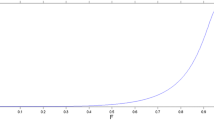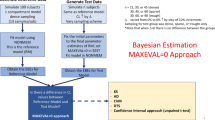Abstract
Nonlinear mixed-effects models are frequently used for pharmacokinetic data analysis, and they account for inter-subject variability in pharmacokinetic parameters by incorporating subject-specific random effects into the model. The random effects are often assumed to follow a (multivariate) normal distribution. However, many articles have shown that misspecifying the random-effects distribution can introduce bias in the estimates of parameters and affect inferences about the random effects themselves, such as estimation of the inter-subject variability. Because random effects are unobservable latent variables, it is difficult to assess their distribution. In a recent paper we developed a diagnostic tool based on the so-called gradient function to assess the random-effects distribution in mixed models. There we evaluated the gradient function for generalized liner mixed models and in the presence of a single random effect. However, assessing the random-effects distribution in nonlinear mixed-effects models is more challenging, especially when multiple random effects are present, and therefore the results from linear and generalized linear mixed models may not be valid for such nonlinear models. In this paper, we further investigate the gradient function and evaluate its performance for such nonlinear mixed-effects models which are common in pharmacokinetics and pharmacodynamics. We use simulations as well as real data from an intensive pharmacokinetic study to illustrate the proposed diagnostic tool.





Similar content being viewed by others
References
Agresti A, Caffo B, Ohman-Strickland P (2004) Examples in which misspecification of a random effects distribution reduces efficiency, and possible remedies. Comput Stat Data Anal 47:639–653
Alonso A, Litière S, Laenen A (2010) A note on the indeterminacy of the random-effects distribution in hierarchical models. Am Stat 64:318–324
Alonso A, Litière S, Molenberghs G (2008) A family of tests to detect misspecifications in the random-effects structure of generalized linear mixed models. Comput Stat Data Anal 52:4474–4486
Boekmann A, Sheiner L, Beal S (1992) NONMEM user’s guide, part V: introductory guide. University of California, San Francisco
Claeskens G, Hart JD (2009) Goodness-of-fit tests in mixed models. Test 18:213–239
Davidian M, Giltinan DM (1995) Nonlinear models for repeated measurement data. Chapman and Hall, New York
Davidian M, Giltinan DM (2003) Nonlinear models for repeated measurement data: an overview and update. J Agric Biol Environ Stat 8:387–419
Drikvandi R, Verbeke G, Molenberghs G (2016) Diagnosing misspecification of the random-effects distribution in mixed models. Biometrics. doi:10.1111/biom.12551
Efendi A, Drikvandi R, Verbeke G, Molenberghs G (2014) A goodness-of-fit test for the random-effects distribution in mixed models. Stat Methods Med Res. doi:10.1177/0962280214564721
Hartford A, Davidian M (2000) Consequences of misspecifying assumptions in nonlinear mixed effects models. Comput Stat Data Anal 34:139–164
Heagerty PJ, Kurland BF (2001) Misspecified maximum likelihood estimates and generalised linear mixed models. Biometrika 88:973–985
Huang X (2009) Diagnosis of random-effect model misspecification in generalized linear mixed models for binary response. Biometrics 65:361–368
Jiang J (2001) Goodness-of-fit tests for mixed model diagnostics. Ann Stat 29:1137–1164
Lange N, Ryan L (1989) Assessing normality in random effects models. Ann Stat 17:624–642
Litière S, Alonso A, Molenberghs G (2007) Type I and type II error under random-effects misspecification in generalized linear mixed models. Biometrics 63:1038–1044
Litière S, Alonso A, Molenberghs G (2008) The impact of a misspecified random-effects distribution on the estimation and the performance of inferential procedures in generalized linear mixed models. Stat Med 27:3125–3144
Mentré F, Escolano S (2006) Prediction discrepancies for the evaluation of nonlinear mixed-effects models. J Pharmacokinet Pharmacodyn 33:345–367
Pan Z, Lin D (2005) Goodness-of-fit methods for generalized linear mixed models. Biometrics 61:1000–1009
Pinheiro JC, Bates DM (1995) Approximations to the log-likelihood function in the nonlinear mixed-effects model. J Comput Gr Stat 4:12–35
Ritz C (2004) Goodness-of-fit tests for mixed models. Scand J Stat 31:443–458
Strenio JF, Weisberg HI, Bryk AS (1983) Empirical Bayes estimation of individual growth-curve parameters and their relationship to covariates. Biometrics 39:71–86
Tchetgen EJ, Coull BA (2006) A diagnostic test for the mixing distribution in a generalised linear mixed model. Biometrika 93:1003–1010
Verbeke G, Lesaffre E (1996) A linear mixed-effects model with heterogeneity in the random-effects population. J Am Stat Assoc 91:217–221
Verbeke G, Molenberghs G (2013) The gradient function as an exploratory goodness-of-fit assessment of the random-effects distribution in mixed models. Biostatistics 14:477–490
Waagepetersen R (2006) A simulation-based goodness-of-fit test for random effects in generalized linear mixed models. Scand J Stat 33:721–731
Author information
Authors and Affiliations
Corresponding author
Rights and permissions
About this article
Cite this article
Drikvandi, R. Nonlinear mixed-effects models for pharmacokinetic data analysis: assessment of the random-effects distribution . J Pharmacokinet Pharmacodyn 44, 223–232 (2017). https://doi.org/10.1007/s10928-017-9510-8
Received:
Accepted:
Published:
Issue Date:
DOI: https://doi.org/10.1007/s10928-017-9510-8




